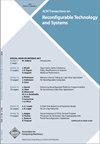Strega:用于fpga的HTTP服务器
IF 2.8
4区 计算机科学
Q2 COMPUTER SCIENCE, HARDWARE & ARCHITECTURE
引用次数: 0
摘要
云计算带来的新机遇、新挑战和新限制正在重塑计算机架构格局。一方面,高级应用程序从专门的硬件中获利,以提高其性能并降低部署成本。另一方面,云提供商通过将基础设施任务卸载给硬件加速器,最大化分配给客户端应用程序的CPU时间。虽然对于网络功能虚拟化和TCP/IP等协议如何做到这一点已经很好理解,但对更高网络层的支持仍然很大程度上缺失,这限制了加速器的潜力。在本文中,我们介绍了S trega,这是一个开源的轻量级HTTP服务器,它支持通过RESTful协议(fpga as-a- function)调用fpga加速函数等关键功能。我们的实验分析表明,单个S trega节点维持每秒1.7 M HTTP请求的吞吐量,端到端延迟低至16 μ S,在这两个指标上都优于运行在32个vcpu上的nginx,甚至可以替代通过PCIe总线的传统OpenCL流。通过这项工作,我们为直接在FPGA上运行微服务铺平了道路,绕过了CPU开销,并在分布式云应用程序中实现了FPGA加速的全部潜力。本文章由计算机程序翻译,如有差异,请以英文原文为准。
The computer architecture landscape is being reshaped by the new opportunities, challenges and constraints brought by the cloud. On the one hand, high-level applications profit from specialised hardware to boost their performance and reduce deployment costs. On the other hand, cloud providers maximise the CPU time allocated to client applications by offloading infrastructure tasks to hardware accelerators. While it is well understood how to do this for, e.g., network function virtualisation and protocols such as TCP/IP, support for higher networking layers is still largely missing, limiting the potential of accelerators. In this paper, we present S trega , an open-source 1 light-weight HTTP server that enables crucial functionality such as FPGA-accelerated functions being called through a RESTful protocol (FPGA-as-a-Function). Our experimental analysis shows that a single S trega node sustains a throughput of 1.7 M HTTP requests per second with an end-to-end latency as low as 16 μ s, outperforming nginx running on 32 vCPUs in both metrics, and can even be an alternative to the traditional OpenCL flow over the PCIe bus. Through this work, we pave the way for running microservices directly on FPGAs, bypassing CPU overhead and realising the full potential of FPGA acceleration in distributed cloud applications.
求助全文
通过发布文献求助,成功后即可免费获取论文全文。
去求助
来源期刊

ACM Transactions on Reconfigurable Technology and Systems
COMPUTER SCIENCE, HARDWARE & ARCHITECTURE-
CiteScore
4.90
自引率
8.70%
发文量
79
审稿时长
>12 weeks
期刊介绍:
TRETS is the top journal focusing on research in, on, and with reconfigurable systems and on their underlying technology. The scope, rationale, and coverage by other journals are often limited to particular aspects of reconfigurable technology or reconfigurable systems. TRETS is a journal that covers reconfigurability in its own right.
Topics that would be appropriate for TRETS would include all levels of reconfigurable system abstractions and all aspects of reconfigurable technology including platforms, programming environments and application successes that support these systems for computing or other applications.
-The board and systems architectures of a reconfigurable platform.
-Programming environments of reconfigurable systems, especially those designed for use with reconfigurable systems that will lead to increased programmer productivity.
-Languages and compilers for reconfigurable systems.
-Logic synthesis and related tools, as they relate to reconfigurable systems.
-Applications on which success can be demonstrated.
The underlying technology from which reconfigurable systems are developed. (Currently this technology is that of FPGAs, but research on the nature and use of follow-on technologies is appropriate for TRETS.)
In considering whether a paper is suitable for TRETS, the foremost question should be whether reconfigurability has been essential to success. Topics such as architecture, programming languages, compilers, and environments, logic synthesis, and high performance applications are all suitable if the context is appropriate. For example, an architecture for an embedded application that happens to use FPGAs is not necessarily suitable for TRETS, but an architecture using FPGAs for which the reconfigurability of the FPGAs is an inherent part of the specifications (perhaps due to a need for re-use on multiple applications) would be appropriate for TRETS.
 求助内容:
求助内容: 应助结果提醒方式:
应助结果提醒方式:


